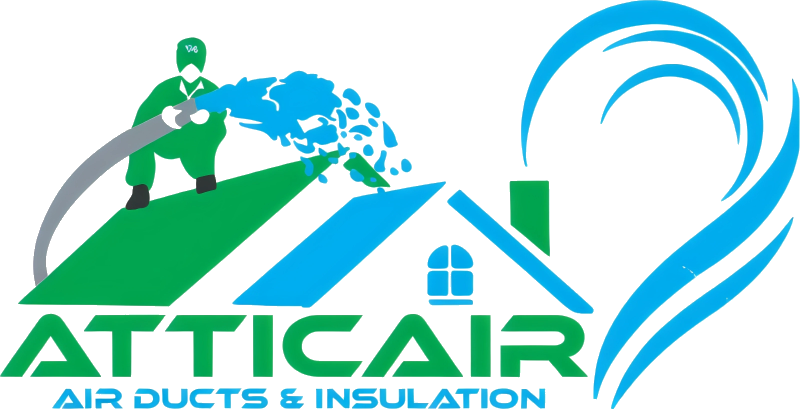Let’s be honest for a second. We spend a lot of time thinking about the temperature in our homes—cranking the AC down on a sweltering Houston afternoon or cozying up when a rare cold front blows through. But how often do we think about the unseen parts of our HVAC system, the intricate network of ducts and insulation working behind the scenes? Probably about as often as we think about cleaning behind the refrigerator.
Out of sight, out of mind, right? Well, that is, until your energy bills start creeping up for no reason, your allergies kick into overdrive, or you notice one room is always a different climate than the rest of the house. Suddenly, that “out of sight” system becomes a real pain point. We see it all the time at our Houston company, Atticair.
So, let’s pull back the curtain and have a real chat about the silent heroes and villains living in your attic and walls.
The Lungs of Your Home: Why Air Duct Cleaning Isn’t Just Hot Air
Think of your air ducts as the respiratory system for your entire house. Every time your aircon kicks on, it’s pulling air from your rooms, conditioning it, and then sending it back through a maze of ducts. Over months and years, that system collects a surprising amount of… well, let’s call it “life debris.”
We’re talking about:
- Dust and dander (pet owners, we see you).
- Pollen and other outdoor allergens that sneak inside.
- Mold spores, especially in our humid Houston climate.
- General construction dust and debris.
Now, imagine blowing air through a clogged filter. Your HVAC system has to work harder, using more energy, to push air through all that gunk. It’s like trying to breathe through a stuffy nose while running a marathon. Not exactly efficient.
So, when is the right time for a professional AC duct cleaning? A good rule of thumb is every 3 to 5 years. But if you notice any of these red flags, it might be time to search for the “best air duct cleaning near me” a little sooner:
- Dust Buildup: You dust your furniture, and two days later, it looks like you haven’t touched it in a month.
- Visible Debris: You can see dust or even worse, mold, around your vent registers.
- Unexplained Odors: A musty smell wafting from the vents when the AC runs.
- Rising Energy Bills: Your usage hasn’t changed, but your cost sure has.
A thorough HVAC cleaning from a trusted company like ours at Atticair doesn’t just improve your air quality; it helps your entire system run more smoothly and efficiently. It’s one of those maintenance tasks you don’t appreciate until it’s done, and then you wonder why you waited so long.
More Than Just a Laundry Chute: The Dryer Vent Danger We Ignore
Okay, let’s move from one hidden duct to another. We all use our dryers regularly, but how many of us give a second thought to the dryer vent? IMO, this is one of the most overlooked safety features in a home.
That flexible tube or rigid pipe running from your dryer to the outside of your house has one job: to exhaust hot, moist air and lint. Lint is incredibly flammable. When the vent gets clogged, that heat has nowhere to go. The result? A drastically increased risk of a house fire. It’s not something we like to think about, but it’s a real and present danger.
Here are a few tell-tale signs your dryer vent is crying out for help:
- Your clothes are taking forever to dry, especially denim or towels.
- The outside of the dryer feels extremely hot to the touch during a cycle.
- You notice a burning smell when the dryer is running.
- The flap on your exterior vent doesn’t open when the dryer is on.
Getting your dryer vent professionally cleaned isn’t just about efficiency; it’s a critical safety measure. It’s one of the most affordable and important services you can schedule for your home. When you call us at Atticair for a comprehensive check-up, we always take a peek at the dryer vent situation because, frankly, it’s that important.
Your Attic’s Winter Coat: The Unsung Hero of Home Comfort
If your air ducts are the lungs, then your attic insulation is the winter coat for your entire house. It’s the barrier that keeps the oppressive Houston heat from baking your living space in the summer and keeps the precious cool air from escaping. When it’s compromised, your HVAC system works overtime, leading to wear and tear and those scary-high energy bills.
How do you know if you need an attic insulation replacement? It’s not always obvious, but your wallet and your thermostat will give you hints.
- Wild Temperature Swings: Rooms directly under the attic are significantly hotter or colder than the rest of the house.
- High Energy Bills: This is a recurring theme because it’s a huge indicator of systemic issues.
- Ice Dams (in colder climates): Or in our case, just a perpetually struggling AC unit.
- Visible Issues: You go into your attic and see compacted, discolored, or thin insulation.
Old, settled, or moisture-damaged insulation loses its R-value—its ability to resist heat flow. Upgrading your insulation is one of the single best investments you can make in your home’s comfort and efficiency. It’s like swapping a thin windbreaker for a heavy-duty parka. The difference is night and day.
Breaking Down the Cost: An Investment, Not an Expense
We get it. The first question on everyone’s mind is, “What’s this going to cost me?” It’s a fair question. The price for these services can vary widely depending on the size of your home, the extent of the problem, and the company you hire.
But let’s reframe this for a second. This isn’t an expense; it’s an investment. You’re investing in:
- Lower monthly utility bills.
- The longevity of your expensive HVAC system.
- The air quality your family breathes every day.
- The safety of your home.
While we always aim to provide affordable and transparent pricing at Atticair, going with the cheapest option can often cost you more in the long run. A lowball cost might mean cut corners, inadequate equipment, or a crew that’s in and out in an hour without doing a thorough job. You want a company that does the job right the first time.
To give you a rough idea, here’s a table breaking down what generally influences the cost of these key services.
| Service | Key Factors Influencing Cost | Why It Matters |
|---|---|---|
| AC Duct Cleaning | • Square footage of your home • Number of vents and returns • Level of contamination (e.g., pet dander, mold) • Accessibility of ductwork |
A larger, more complex system takes more time and resources to clean properly. Mold remediation requires specialized equipment and expertise. |
| Dryer Vent Cleaning | • Length of the vent run • Type of vent material (flexible vs. rigid) • Severity of the clog |
A long, convoluted vent run through walls and attics is more labor-intensive to clean effectively. |
| Attic Insulation Replacement | • Attic square footage • Type of insulation chosen (e.g., blown-in, batts) • Desired R-Value • Need for removal of old insulation |
Achieving a higher R-Value requires more material. Removing old, hazardous insulation like vermiculite adds to the project scope and cost. |
Residential vs. Commercial: It’s a Whole Different Ballgame
Now, everything we’ve talked about so far primarily applies to our homes. But what about your business? The principles are the same, but the scale and stakes are often much higher.
Commercial HVAC systems are beasts. They service more square footage, have more complex ductwork, and run for longer hours. The need for regular, professional HVAC cleaning in a commercial setting isn’t just about comfort; it’s about productivity, protecting inventory, and ensuring a healthy environment for employees and customers. A clogged system in a restaurant or retail store can be a business-killer. The scope of work for a commercial project is why you need a company with the right equipment and experience, which is a core part of the services we offer at Atticair for our business clients in and around Houston.
Your Top Questions, Answered Straight
We hear questions from homeowners every day. Here are some of the most common ones.
1. How often should I really replace my HVAC air filter?
Great question! For most homes, every 90 days is standard. But if you have pets, allergies, or live in a particularly dusty area, swap it out every 30-60 days. It’s the easiest and cheapest piece of maintenance you can do. A clean filter protects your system and improves air quality.
2. Can’t I just clean my air ducts myself with a shop vac?
We love a good DIY spirit, but this is one we’d advise against. A shop vac simply doesn’t have the suction power or the specialized tools (like rotary brushes and compressed air whips) to effectively agitate and remove debris deep within the ductwork. You might clean the first few feet, but you’re leaving the majority of the contamination behind. Sometimes, you just need to call a pro 🙂
3. What’s the difference between “air duct cleaning” and “HVAC cleaning”?
This is a subtle but important distinction. Air duct cleaning typically focuses just on the supply and return ducts. HVAC cleaning is more comprehensive and includes cleaning the internal components of your actual HVAC unit—the blower motor, coils, drain pan, etc. A full-system clean is always the best approach for overall health.
4. How long does an average attic insulation replacement take?
For an average single-family home, a professional crew can typically remove old insulation and install new material in a single day. It’s a surprisingly fast process that yields immediate results. You’ll feel the difference the very next time your AC turns on.
Wrapping It Up: Breathe Easy, Houston
Look, maintaining a home is a never-ending list of to-dos. But taking care of the unseen parts of your house—the ducts, the vents, the insulation—pays you back in comfort, savings, and peace of mind. It’s not the most glamorous home improvement project, but it’s arguably one of the most impactful.
You don’t have to navigate this alone or wonder if you’re getting the best service for your money. If you’re in the Houston area and any of this resonated with you, why not give us a shout at Atticair? Let’s make your home the comfortable, efficient, and healthy space it’s meant to be. After all, we could all use a little easier breathing, both literally and figuratively.

